第二章基本交际理论
《人际沟通》第二章第三节人际认知理论
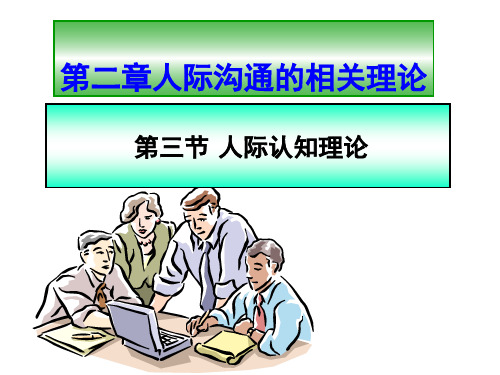
第二章人际沟通相关理论
第三节人际认知理论
2、人际认知的特征
1)知觉信息的选择性 2)认知行为的互动性 3)印象形成的片面性
第三章人际关系基础理论
第二节人际认知理论
(二) 人际认知的内容
1、自我认知:是指在社会实践中,对 自己的生理、心理、社会活动以及 对自己与周围事物的关系进行认知。 2、他人认知:是指对交往对象的正确 认识。
认经验。
第二节人际认知理论
(二)认知形成的心理效应◎
7、投射效应:
是指在人际交往中,总是假设他人与自己有着相同特性的
倾向,即把自己的特性投射到其他人身上。典型的投射效应 就是人们常说的”推己及人“,认为别人与自己一样有着相同 好恶、相似的观点在人际交往中表现形式多种多样。所谓
“以小人之心,度君子之腹”,反应的就是投射效应的一个侧面。
(三)赞许动机 ◎
社会心理学家认为,人总是通过与他人的交往, 来增加对自己的认识。所谓赞许动机,是指交际 的目的能得到对方的鼓励和称赞,从而获得心理 上的满足。赞许动机实质上是 一种取得成就而得 到他人或组织的尊重、承认和赞扬的需要。赞许 动机对于人际交往行为的成效是有直接影响的。 我们在实际交往中,要诚恳、不失时机、恰当地 使用赞誉,强化人的交际动机,激励人的积极行 为。
人们对别人做评价时。常喜欢从好的坏的局部印象出发,
扩散出全部的好货坏的整体印象,就像月晕一样,从一个中心
点组建扩散成一个越来越大的圆圈,所以也称月晕效应。
第二节人际认知理论
(二)认知形成的心理效应◎
3、人的外表具有明显的晕轮效应。晕轮效应对恋爱
的双方其更明显的作用,正所谓“情人眼里出西施”。
晕轮效应所产生的认知偏见从已知推及未知、由片面 看全面,往往导致不正确的评价。人际交往中应避免, 但同时也可利用这一点增加自身的吸引力。
第二章 交际与跨文化交际PPT
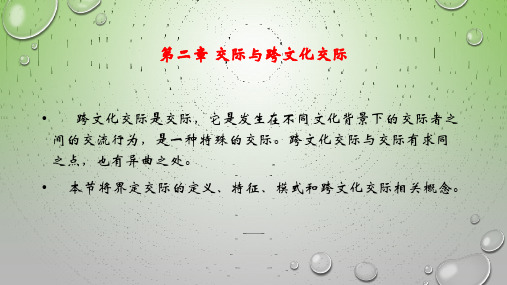
2、跨文化交际学的研究方法和研究内容
• 与跨文化交际学关系最密切的有四门学科是文化人类学、 社会心理学、社会语言学和传播学。不同学科的学者在研究跨 文化交际时所取的角度不同,研究方法上亦有差异。
• 作为一门独立的边缘学科,跨文化交际学不仅研究文化的定 义与特点、交际的定义与特征以及文化与交际的关系,同时将干 扰交际的文化因素也作为它研究的重中之重。
(1)培养人们对不同文化持积极、理解的态度。在这个过程中,我 们能够加深对自身文化的理解,从而做到客观地把握各自的文化特性。
(2)培养跨文化接触时的适应能力。设法减缓冲击、提高适应能力 是使跨文化交际得以成功进行的唯一途径,这也是跨文化研究的一项 重要内容。
(3)培养跨文化交际的技能。在美国,除了在大学里设置了相关课 程以外,社会上也有许多机构专门负责跨文化交际技能的培训和进修, 以此来适应国际化社会的需要。正是基于这一点,跨文化交际研究的 实践意义要远远大于它的理论意义。
• 相比较而言,我国的跨文化交际研究的历史很短。上世纪八十年代中 期开始,我国学者们才注意到这方面的问题,其研究初期的重点是放在外 语教学以及文化及语言的关系上。自1982年许国璋先生发表论文 《CULTURALLY-LOADED WORDS AND ENGLISH LANGUAGE TEACHING》之后,学者们谈论文化差异的文章越来越多,并相继发表在 各种学术刊物上。
• 交际中,具有同一文化背景的人们可以进行有效地交流,而因为 共享有限的文化背景,来自不同文化中的人们,在交流时常常会产生 沟通的障碍。
• 这就是我们所说的跨文化交际。
一、交际的定义
• 《辞海》中“交际”词条下的释义:“敢问交际,何心也?” 朱熹注:“际,接也”。“交际”谓人以礼仪币帛相交接也。据 此意义,该词后来泛指社会各阶层成员交往中人与人的往来应酬。
交际理论ppt课件

• 1、 Hy1972)认为交际能力应包括四个社会文化因素:
(1)可能性程度(degree of possibility)。某一语言系统中
可能存在的东西。如语音、语法、句法、词汇、语义、
语用等方面的知识。
(2)可行性程度(degree of feasibility)。语言使用者个人
交际能力理论
1
交际能力理 论
交际能力理论首先是由海姆斯(Hymes)于1972年提 出,它将乔姆斯基(Chomsky)的语言能力范围扩大至 四个方面: 判断某一语言形式是否正确; 判断某一语言形式在特定的场合中是否得体; 判断某一语言形式是否实际可行; 判断某一语言形式是否在实际中使用。 这四个方面能力的组合就构成了交际能力。
音、句法等方面),主要涉及正确理解和表达话语的字面 意义的知识,也就是遣词造句的能力。 (2)社会语言能力。指在不同的社会语言环境中适当理解和 表达话语的能力。语境因素包括话题(topic)、交际双方 的社会地位和交际目的。话语应该在语义和形式两方面 都是适当的。
5
(3)语篇能力。指把语法形式和意义融合在一起,用口头或 书面形式连贯地表达不同种类语篇的能力。语篇的完整 统一通过语言形式的衔接和语义的连贯来实现。语篇能 力也就是超句平面上组织语段的能力。
巴克曼的交际语言能力学说是迄今为止我们所能见到的 关于语言能力学说中最全面、最完整的学说。
7
Bachman借鉴和发展了Halliday (1976)、 Hymes(1972)等人的研究成果,首先他把交际能力改 称为语言能力(language competence),提出了自己 的语言能力观:
(1)语言能力应包括语法规则知识和如何使用语言达到特 定交际目的的知识。
言语交际基础理论

• • • • •
方达生 陈白露 方达生 陈白露 方达生
• 陈白露
• 方达生
竹均,怎么你现在会变成这样—— 这样什么? 呃,呃,这样地好客,——这样地爽快。 我原来不是很爽快么? 哦,我不是,我不是这个意思。我说,你 好像比从前大方得—— 我从前也并不小气呀!哦,得了,别尽捡 好听的话跟我说了。我知道你心里是说我 有点太随便,太不在乎。你大概有点疑心 我很放荡,是不是? 嗯——对了。你比以前改变多了。
附:跨文化交际 秘书:您好,您是王老先生吧?一路辛苦!您老请上 坐。您高寿? 王先生:六十五岁。 秘书:您老这么大年纪了,还亲自跑一趟,我们真不 知说什么好? 王先生:这没什么。 秘书:(指指满桌精美的饭菜)没什么好东西,几杯 薄酒,几样俗菜,聊表心意,请慢用。
1、言语交际过程的实质 说言语交际是一个过程,其最基本的意义是指将交际 双方甲和乙的脑子里存在着“概念”和“音响形象” 之间相互的转化作了描述。说话人把“概念”转化为 “音响形象”而发出声音,听话人则把自己听到的声 音还原为“音响形象”再转化为“概念”。
“对不起,太太,您是谁?我好像不认识您。”
“我实在受不了了。我要和他一刀两断,这个无赖。” “我是斯特劳医生,请问您找谁?” “这个混蛋骗了我好几年,背着我和另外一个女人睡 觉,把我和孩子丢在一边不管 ” “对不起,太太,您是谁?我好像不认识您。” “他挣的钱一分也不往家里拿,叫我们娘儿几个用什 么过日子? ” “太太,我不认识您,您拨错了 ” “什么,我错了,我根本没错 ” “太太,我不认识您。” “对不起,我知道你不认识我,但我心里的话总得跟 人说啊!谢谢您听完了我的话,我的感觉现在好多 了。”
• 做人不能太陈凯歌了——不能陈凯歌到这种地 步——陈凯歌下去——不能陈凯歌了——陈凯歌 已经相当陈凯歌了——陈凯歌为什么就不能陈凯 歌——我就是想陈凯歌也陈凯歌不成呀 • 男人没有了女人就恐慌了。 • 走不出去——不走出去—— 走出去不——出去走不 • 不怕辣——怕不辣吃饭喽、吃饭呗、 吃饭哩、吃饭吗、吃饭呢、吃饭呀 • B:吃了饭、吃过饭、吃着饭、吃的饭 • C:在吃饭、正吃饭、刚吃饭、才吃饭、还吃饭、 已吃饭、不吃饭、再吃饭、正在吃饭 • D:对吃饭、把吃饭、被吃饭、让吃饭、关于吃 饭、自从吃饭、因为吃饭、除了吃饭 • E:吃饭和喝水、吃饭或喝水、吃饭且喝水、不 但吃饭而且喝水
大学课程《人际交往与沟通(第二版)》PPT课件:第二章 人际交往与沟通理论

生理需求 安全需求
社交需求
尊重需求 自我实现需求
自主进化
自我实现需求: 真善美至高人生 境界获得的需求 尊重需求:成就、名 声、地位和晋升机会
等
社交需求:友谊、爱情及其隶属 关系的需求
安全需求:人身安全、生活稳定以及免遭痛 苦、威胁或疾病等,以及对金钱的需求
生理需求:食物、水、空气、性欲、健康
六、尤尔根·哈贝马斯的交往行为理论
前的困难,一点儿一点儿、谨慎地透露这个坏消息, 还得允许他们提出疑问和要求,这样的话能在很大程 度上减少对他们情感的打击。可你倒好,‘唰’一下 子,给他们统统发了电子邮件,且在周五晚上,他们 在家收到邮件后,整个周末,两天多啊,炸窝了,差 不多都处在极度焦虑狂躁中,受不了啦,等不到今天 上班再说啦,到处打电话诉说自己的不幸、倒霉啊, 现在是流言满天飞,说学院要黄了,要破产了,学院 现在正处于一种近乎骚乱的局面。”
学习任务:
理论任务: ①个体层面:自我意识、社会知觉、社会态度、社会动机 ②人际层面:人与人之间的相互作用 ③群体层面:群体心理氛围,个体与群体的相互作用 ④社会层面:人际交往风俗、时尚、阶用中,心理活动发生、发展和变 化的规律,解释、预见、调控人们的社会交际心理及其 行为。 ②认识自己以及自身的角色,提高自身素质,将生活意 识转化成人际交往的科学意识。 ③从社会人的本质和规律性的高度,在更高的水平上俯 瞰社会交际现象,发挥社会心理学理论的预测、调节和 控制的实践作用。
学习任务:
理论任务: ①不断优化人际交往心理学的理论内涵。 ②了解与明晰个人、群体、个人与个人、个人与群体 之间的交互方式及其作用。 ③深化人际态度、自我知觉、心理控制、人际影响、 人际吸引、人际冲突、群体行为等对人际关系的影响。 ④为完善人际交往心理学的科学理论体系提供充足的依 据。
语言交际概说

语言交际概说交际是一种特定的人际行为,包括交际对象、交际意图、交际行为三个方面,缺一不可。
交际是一种人际行为,既然是人际行为,那就必须得有对象。
所以如果你喉咙痒了,你咳嗽一下,你有咳嗽没有任何针对性,也没有特定对象,那这个就是一般行为而不属于交际行为。
但是如果你为了表达某个不便直说的意图,你故意对某个人咳嗽一下,这就属于交际了。
其中你不便直说的意图就是你的交际意图。
而你咳嗽的对象就是你的交际对象,你的咳嗽本身就是你的交际行为。
所以,有意图,有对象,有行为这三者才构成交际。
再比如,如果你在公园看到一个三人坐的长椅,你什么都没想就直接坐到中间,这就是一个一般行为,如果你坐的前几秒看见也有人往这边走来,你不希望那个人坐到这个长椅上,所以你选择了坐在中间,这就是一个交际行为。
尽管你没有和这个人产生任何对话或直接接触,但是你的行为向他发出了不希望他做到这里的信息,这就属于交际了。
因为在这个过程中,你有明确的交际意图,那就是不希望他也坐到这儿;你有特定的交际对象,那就是正在走过来的那个人;你也发出了交际行为,就是你坐到了椅子中间。
所以,于你而言,尽管你一句话都没说,但是你用体态语表明了一切。
这就是你的交际了。
面对你的行为,对面的人可能看到了并感受到了你的用意,于是,他走向另一个长椅,你的交际就成功了。
如果那个人没有注意到你的行为,也没有发现其他长椅就直接做了过来,那你刚才的交际就失败了。
失败的交际也是交际,没有人能保证自己的交际都是成功的。
交际的六个特征:第一,交际具有社会性,因为交际是一种社会现象。
人类的任何交际都在一定的社会条件下进行的,因此都会带有那个社会和时代的烙印。
第二、交际具有个体性。
因为交际都是通过每一个个体完成的。
第三、交际具有互动性。
有的互动是当场完成的,比如面对面的口头交际,有的互动呢,是经过了一段时间或一个周期之后才完成的。
比如书信往来或者人际交往当中物质上的礼尚往来等等。
第四、交际具有动态性。
《演讲与口才》教学大纲

《演讲与口才》教学大纲课程编码:021*******课程名称:演讲与口才学时/学分:32/2先修课程:适用专业:汉语言文学、汉语国际教育开课教研室:汉语教研室一、课程性质与任务1.课程性质:本课程是汉语言文学专业、汉语国际教育专业的专业课。
2.课程任务:“演讲与口才”是研究口语运用规律的一门应用语言学科,是在理论指导下培养学生在教育、教学、日常交际等活动中口语运用能力的实践性很强的课程。
本课程以理论教学为基础,重点加强实践教学。
通过该课的学习,力求使学生了解言语的基本性质特征,认识言语交际活动的基本规律,从而能在实际的言语活动中把握这些规律,提高言语表达和交流的水平,更好地适应现代社会对人的言语表达与沟通能力的要求。
本课程重在引导学生认识语言训练的重要意义,培养学生树立口语交际的意识,了解不同类型言语交际的语言特征,掌握语言训练的方法和要领,学会不同类型的口语表达,提升口语表达能力。
二、课程教学基本要求主要教学环节包括课堂讲授、案例分析、小组讨论、课堂训练等。
在课堂教学中要认真贯彻“以学生为主体,以教师为主导,以训练为主线”的教学主导思想,立足课堂,精心设计,强化训练。
教学要求分为三个层次:熟练掌握,一般把握,一般了解。
对于基本的理论要求熟练掌握,并能应用于实践中去。
对于一般的案例分析要求一般把握,重要的是把握其中的规则和共性问题,对具体问题作具体分析。
对于扩充的知识作一般的了解,主要是扩大知识面。
成绩考核形式:课程成绩=期终成绩(70%)+平时成绩(期中考核、作业、课堂提问等)(30%)。
成绩评定采用百分制,60分为及格。
三、课程教学内容第一章演讲口才概说一、教学基本要求掌握演讲与口才的学习方法,了解言语交际的有关概念;明确口才训练的意义。
二、要求学生掌握的基本概念、理论、技能通过本章学习,要求学生了解言语交际的过程及言语交际的基本要素,明白演讲与口才学科的概况、演讲与口才研究对象和范围,掌握演讲与口才的学习方法。
交际理论

Hymes(1972)认为交际能力应包括四个社会文化因素: (1)可能性程度(degree of possibility)。某一语言系统中 可能存在的东西。如语音、语法、句法、词汇、语义、 语用等方面的知识。 (2)可行性程度(degree of feasibility)。语言使用者个人 心理方面的语言容量,如个人的记忆力和认知能力。 (3)合适性程度(degree of appropriateness)。在交际中言 语行为的表达是否得体,如对交际背景、目的、常规、 参加者等因素的合理考虑。 (4)出现性程度(degree of performance)。言语行为能否发 生。
巴克曼认为语言能力应由两大子能力组成: (1)语言的组织能力,语言组织能力包括语法能力 (词汇、语法、句法、语音)和语篇能力(衔接、 修辞); (2)语用能力,语用能力包括言外能力(表意功能、 操作控制功能、启发功能、想象功能)和社会 语言能力(对语言变体的敏感性、对语域的敏 感性、对地道语言的敏感性、对文化所指和修 辞语的敏感性)。
• 2、 Canale和Swain的交际能力理论
卡纳尔和斯温(Canale and Swain)的交际能力学说充实 并丰富了Hymes的交际能力学说。在20世纪80年代,该模式 在应用语言学界影响广泛。他们认为交际能力包括四个方面 的知识和技能: (1)语法能力。指语言本身的知识(包括词汇、构词规则、语 音、句法等方面),主要涉及正确理解和表达话语的字面 意义的知识,也就是遣词造句的能力。 (2)社会语言能力。指在不同的社会语言环境中适当理解和 表达话语的能力。语境因素包括话题(topic)、交际双方 的社会地位和交际目的。话语应该在语义和形式两方面 都是适当的。
Bachman的交际语言能力模式比旧模式确实 有了质的改进,与Canale模式相比,该模式突出了 语用能力和语言的功能,突出了理解话语的交际意 图。另外,该模式把Canale的策略能力从交际能力 整体框架中独立出来,认为他起着一种“执行” (executive)最后决定的功能。对近十年来的外语 教学和测试产生了深刻的影响。 但是,如何正确理解交际语言能力的各个方面, 尤其是如何理解其中的语用能力和策略能力,还有 待我们进一步探讨。
第二章 言语交际语言学的一般理论
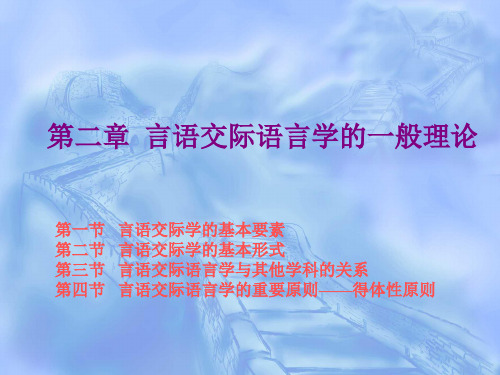
第四节 言语交际语言学的重要原则 ——得体性原则
交际是一门艺术。要想获得交际的成功, 必须具备多种多样的条件。其中最重要的条 件之一就是得体的言语。
一、礼貌准则 (一)礼貌准则概说 礼貌准则就是那些制约言语行为的礼 貌规范,是个人文化修养的体现。
(二)礼貌准则中次准则的运用 1.宽宏次准则 2.赞誉次准则 3.谦虚次准则 4.一致次准则 5.同情次准则 6.称呼次准则
二、言语交际语言学与思维逻辑学 (一)言语交际与现代思维逻辑推理 1.概念 2.判断 3.推理
(二)言语交际的逻辑功能 1.预设功能 2.反驳功能 3.反逻辑功能
(三)言语交际的逻辑手段趣例 1.转化法 2.抵言法 3.强推法 4.类推法 5.归谬法
6.诡谐法 7.歧义法 8.奇答法 9.旁逸法 10.杂糅法 11.误推法
(二)狭义副语言 狭义的副语言包括“辅助语言符号系 统”和“语言外符号系统”。前者是发声 系统,指的是音强、音质、音高、发音的 清晰度等。
1.辅助语言符号系统 2.语言外符号系统
ห้องสมุดไป่ตู้
(三)广义副语言 1.身势语 2.服饰语
第三节 言语交际语言学与其他 学科的关系
据有关研究表明:只有三分之一的人类 交流是由有声言语完成的,其他都属于无声 言语交际。无论有声与无声的言语交际都与 各种学科有着千丝万缕的联系。
三、言语交际环境——语境 任何言语交际总是人们在某一特定的 时间、地点、情境中,为某一目的与某人 进行的活动。
四、话语 任何言语交际都是以语言为工具,以 说、写和所说、所写的言语形式来进行的。 言语交际过程中的话语是人们表达和理解 的焦点。
五、Speaking说 美国宾夕法尼亚州立大学的语义哲学 家海默斯(Dell Hymes)提出了“言说的 种族学”理论,他认为,在言语活动中包 含17个因素,分为8类,以字母为代表, 就是S P E A K I N G,正好是“speaking”一 词。
人际交往的基本技巧目录

人际交往的基本技巧目录第一章:积极正面的身体语言-目光接触:与人交往时,保持适当的目光接触能够传达出你对对方的关注和尊重。
-笑容:微笑是人际交往中非常重要的一个元素,它能够表达友好和愉快的情绪。
-姿势:保持开放的姿势,例如不要交叉双臂,可以表达出你对对方的真诚和开放。
第二章:聆听和表达-积极聆听:聆听是人际交往中非常重要的技巧,它能够帮助你理解对方的需求和感受。
积极聆听包括注意力集中在对方身上、回应对方的发言和提问以进一步了解对方。
-清晰表达:在与他人交流时,清晰地表达自己的观点和需求是非常关键的。
使用明确的语言和亲和的语气,以便对方更好地理解你的意思。
第三章:建立信任和共鸣-诚实与真实:与他人建立信任的前提是诚实和真实。
坦率地与对方交流,承认自己的错误并尊重对方的意见。
-共鸣:共鸣是与他人建立深层连接的一个重要技巧。
试着从对方的角度去理解问题,表达出你对对方的理解和关心。
第四章:处理冲突-冲突解决的重要性:人际关系中难免会出现冲突,但如何处理冲突将关乎是否能够保持良好的关系。
识别冲突的原因,并试图通过沟通、妥协和合作来解决问题。
-处理冲突的技巧:善于倾听双方的观点,表达自己的需求和担忧,避免指责和攻击性语言。
第五章:展示尊重和关心-尊重他人:尊重他人的选择、意见和权益是建立良好人际关系的基础。
试着理解对方的观点并接受他们的差异。
-表达关心:表达对他人的关心是维系人际关系的重要一环,例如通过询问对方的情况、关心他们的需要和帮助他们解决困难。
第六章:灵活应对不同的人群-适应不同的沟通风格:不同的人有不同的沟通偏好,你可以通过观察和了解他们来适应他们的沟通风格。
-尊重文化差异:在与不同文化背景的人交往时,要尊重他们的文化差异,避免冒犯他们的习俗和信仰。
结语:人际交往是一个复杂的过程,它需要时间和练习来提高你的技巧。
尝试着应用这些基本技巧,与他人建立良好的人际关系,并享受互动和分享的乐趣吧!。
社交礼仪 第二章 交际沟通原理与技巧

Dispersed my former reveries, distillation.
And I forgot your tender voice,
Your features so divine.
My heart again resounds in
rapture,
In exile, in confinement’s gloom, Within it once again arise
▪ 3.能此者大道坦然,不能者孤帆片舟——第三条原则:引起 他人内心的愿望
▪ (二)是使别人喜欢你的6种方法 ▪ 1.真诚地关心别人 ▪ 2.微笑 ▪ 3.记住:对一个人来说,他的名字是最亲切、最重要的声音 ▪ 4.健谈者,首先要成为一个倾听者 ▪ 5.谈论别人感兴趣的事情 ▪ 6.永远使他人感到自身的重要
My uneventful days wore on,
Feelings of awe and
Bereft of awe and inspiration inspiration,
Bereft of tears, of life, of love.
Of life itself, of tears, and love.
▪ 社会普遍的现象——IQ 160的为IQ100的人工作。
美国,人们流行一句话:“智商(IQ)决定录用,情 商(EQ)决定提升”。
第四节
▪卡内基的交际理论与技巧
▪ (一)卡内基待人的基本原则 ▪ 1.如果你要采蜜,不可弄翻蜂巢——第一条原则:不要责怪
或抱怨
▪ 2.与人相处的一大秘密——第二条原则:给予诚心诚意的赞 赏
My soul awakened once again:
dreams.
交际语言学第二章 交际语言学的一般理论
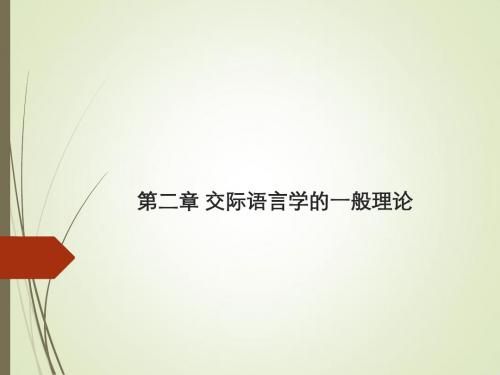
13 三、副语言
(一)副语言概说 交际语言学的主要部分是言语交际语言学,但交际语言学的范围又宽于言语交际
语言学, 一些非言语交际活动也可纳入研究的范围。人类交际时的一些非言语交 际所用的工具形式我们 可以称为副语言,它不完全等同于有系统的语音、词汇、 语法的语言形式。 副语言 ( p a r a l angu a g e)又称类语言或伴 随语言,也可称为副语言特征或伴随语言特征 ( p a r a l i ngu i s t i cf e a t u r e s)。研究副语言的科学叫做副语言学、类语言学或 伴随语言学 ( p a r a l i n gu i s t i c s),甚至可以称为非 言语交际语言学。 副语言有广义和狭义之分。狭义的副语言只包括伴随言语的某 些声音现象,广义的副语言 除包括前者外,还将体态动作、面部表情,甚至某些 书写符号、言语及交际的情境都包括 在内。
第四章
12 二、书面形式 (书面语言)
书面交际是一种运用语言文字工具的重要交际形式。它区 别于口语交际的显著特点是运用 书面形式进行交际,不 会受到时间、地点的制约,而且在初稿写完之后还可以进 一步修改,以 期准确、规范。因此,书面交际往往用于 较为正式的场合,具有长效性和权威性。书面语言可 以 分为公文体、新闻体、广告体三种。
第四章
知识9 链接:
美国宾夕法尼亚州立大学的语义哲学家海默斯提出了 “言说的种族学”理 论,他认为,在 言语活动中包含17个因素,分为8类,以字母为代表, 就是 S P E AKI NG,正好是 “ s p e ak i ng”一词。这8 个方面,即言说 ( s p e ak i ng)形成一个 “语义域”,或 “语义场”。具体 地说,S指具体运用语言的环境和场景 ( s e t t i ng,s c e n e);P指言语活动的参与者 ( p a r t i c i p an t s),包括说者、听者、旁听者;E指言说的目的 ( e nd s);A指一定的说话方式或行为系列 ( a c ts e qu e n c e);K指说话时的语气和心态,即说话的基调 ( k e y);I指 说话时用的具体语言类 型或语言工具 ( i n s t r ume n t a l i t i e s);N指说话时声音的高低,即语言的规范 ( no rm s);G指语 言表达公式的类型,如寒暄、问话等 ( g e n r e s)。
应用语言学的基本理论

二、交际理论 2、交际理论的基本内容。 (1)交际能力是最基本的语言能力。 (2)在多样的语言交际中时间语言交际能力。
语言交际是多层次交叉的,所以要在多样、鲜 活的语言交际中实践语言交际能力。 鲜活还有时 代性。语言学习还要有一定的量和质。一定的量, 可以内化,可以生巧。一定的质,可以提高层次。
Page 11
二、交际理论 (4)语言交际能力的时间不是一次性就完成的。 一个人的语言素质结构还可能滑坡。语言交际 能力的实践不是一次性完成的。 (5)要重视创新。 一切语言示范者要在语言规范尤其是语言创新 方面起到表率作用。对学生语言学习的测试,也 要注意语言创新方面的测试。
?三如果应用本身没有理论一般说理论应用的结果应该是相同的而现在理论应用的结果往往很不同说明应用本?四按照实践应用理论实践应用的层次递进的理论上位的理论应该包含下位的实践应用上位的实践应用应该包含下位的理论
第四章
应用语言学的基本理论
g
提要:
一、 概述 应用语言学基本理论的 缘由。
二、应用语言学基本理论之交际理 论。
Page 12
Page 5
一、概述
五、应用语言学同本体语言学一样从语言学之 外吸取了许多理论。 第二阶段是梳理了应用 语言学的一些基本理论。例如层次理论、动态 理论、中介理论、人文 性理论、潜显理论。
Page 6
一、概述
确定了应用语言学具有理论,带来了 语言学的一种新分类。
原先的一种分类是理论语言学和应用 语言学,认为前者有理论和谈理论, 后者没有理论只是前者理论的应用。 这种分类里没有本体语言学。
Page 7
一、概述
新的分类是: 一、本体语言学。 二、应用语言学。两者都有理论,原 有 的普通语言学常常指本体语言学的 基础理论。三、语言学理论,也有人 称为语言哲学,是本体语言学理论和 应用语言学理论的融合和提升。
人际关系学重点复习资料

第二章人际关系的主要理论一、名词解释1、角色:特指某一个体在社会关系中所处的一定社会地位以及与之相联系的符合规范的行为模式。
2、角色扮演:是指个人在不同的年龄阶段、社会职位、时间场合、面对不同的交往对象所表现出来的行为。
3、角色期望:是指社会、团体或他人对角色扮演者行为的期待或要求,是个人行为的动机4、剧班:是指两个以上的表演者共同组成的表演单位。
5、角色外沟通:特指私下交往和表演二、选择题1、马克思(KarlMarx1818-1883)是全世界无产阶级的伟大导师和领袖。
他致力于对社会发展一般规律的研究。
2、人际交往是指个人与个人的交往,马克思认为人际交往在本质上是社会交往。
3、交往本身要受每个人的不同志向、性格、爱好等因素的影响,但同时又受社会生产的制约。
4、人际关系理论也称为人际关系学说。
5、美国学者梅奥是人际关系理论的创始人。
1927年应邀参加霍桑实验。
6、霍桑是美国芝加哥的一座工厂。
7、马斯洛学说的理论基石是他的动机理论。
他认为人的动机原动力是人的基本需要,这些需要属于人的本性。
8、儿童时代的经验可能形成三种个体行为的控制类型,即拒绝型、独裁型、民主型。
9、角色扮演是指个人在不同的年龄阶段、社会职位、时间场合、面对不同的交往对象所表现出来的行为。
10、戈夫曼所说的不协调角色有五种:告密者、表演者的同谋、职业侦探、中介人、雇员或仆人。
11、人际交换理论的代表人物霍曼斯。
12、人的三种不同心态:每个人身上都好象保留着儿童时代的特征、每个人身上又都好象存在着自己父母的特征、一个正常人具有的客观冷静理智的心态。
13、伯恩内的《人们玩弄的游戏》中明确了相互作用的概念。
14、在相互作用分析理论中父母、成人、儿童都是特指个性的心理状态。
15、人际关系认识平衡理论起源于格式塔理论。
16、格式塔心理学又称完形心理学。
三、简答题1、马克思的社会交往理论?人际交往是社会交往——人际交往是指个人与个人之间的交往。
翻译的语言学派之交际理论派
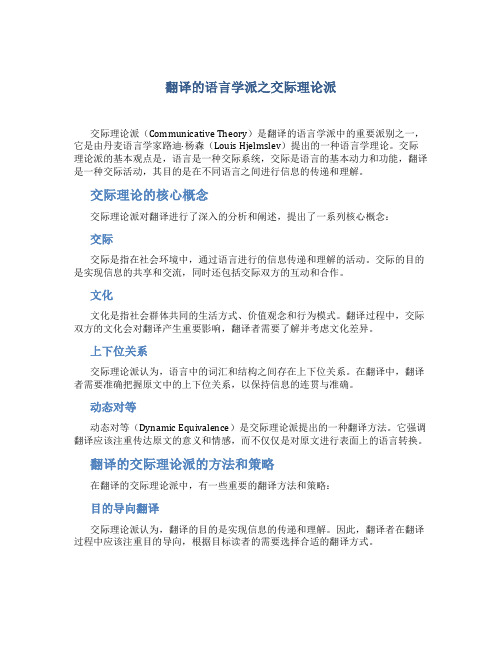
翻译的语言学派之交际理论派交际理论派(Communicative Theory)是翻译的语言学派中的重要派别之一,它是由丹麦语言学家路迪·杨森(Louis Hjelmslev)提出的一种语言学理论。
交际理论派的基本观点是,语言是一种交际系统,交际是语言的基本动力和功能,翻译是一种交际活动,其目的是在不同语言之间进行信息的传递和理解。
交际理论的核心概念交际理论派对翻译进行了深入的分析和阐述,提出了一系列核心概念:交际交际是指在社会环境中,通过语言进行的信息传递和理解的活动。
交际的目的是实现信息的共享和交流,同时还包括交际双方的互动和合作。
文化文化是指社会群体共同的生活方式、价值观念和行为模式。
翻译过程中,交际双方的文化会对翻译产生重要影响,翻译者需要了解并考虑文化差异。
上下位关系交际理论派认为,语言中的词汇和结构之间存在上下位关系。
在翻译中,翻译者需要准确把握原文中的上下位关系,以保持信息的连贯与准确。
动态对等动态对等(Dynamic Equivalence)是交际理论派提出的一种翻译方法。
它强调翻译应该注重传达原文的意义和情感,而不仅仅是对原文进行表面上的语言转换。
翻译的交际理论派的方法和策略在翻译的交际理论派中,有一些重要的翻译方法和策略:目的导向翻译交际理论派认为,翻译的目的是实现信息的传递和理解。
因此,翻译者在翻译过程中应该注重目的导向,根据目标读者的需要选择合适的翻译方式。
上下位关系的处理在交际理论派中,翻译者需要准确把握原文中的上下位关系,并在目标语言中找到合适的表达方式。
这需要翻译者有丰富的语言知识和对原文的深入理解。
文化因素的考虑文化是翻译过程中一个重要的影响因素。
交际理论派强调翻译者需要了解并考虑文化差异,避免因文化差异引起的误解和歧义。
动态对等的运用在交际理论派中,动态对等是一种重要的翻译方法。
它强调翻译应该注重传达原文的意义和情感,而不仅仅是对原文进行字面上的转换。
交际理论

Bachman借鉴和发展了Halliday (1976)、 Hymes(1972)等人的研究成果,首先他把交际能力改 称为语言能力(language competence),提出了自己 的语言能力观:
(1)语言能力应包括语法规则知识和如何使用语言达到特 定交际目的的知识。 (2)语言使用是一个动态过程,语言能力的各成分之间互 相作用。
但应该指出的是尽管hymes的交际能力试图使交际能力与一定的语境对象目的联系起来但它仍和chomsky1965的能力一样是一个绝对的静态的抽象的和理想化的概念因而语言行为在该描写模式中可以形式化规则化和公式化
交论首先是由海姆斯(Hymes)于1972年提 出,它将乔姆斯基(Chomsky)的语言能力范围扩大至 四个方面: 判断某一语言形式是否正确; 判断某一语言形式在特定的场合中是否得体; 判断某一语言形式是否实际可行; 判断某一语言形式是否在实际中使用。 这四个方面能力的组合就构成了交际能力。
(3)语篇能力。指把语法形式和意义融合在一起,用口头或 书面形式连贯地表达不同种类语篇的能力。语篇的完整 统一通过语言形式的衔接和语义的连贯来实现。语篇能 力也就是超句平面上组织语段的能力。 (4)策略能力。也叫补偿能力,指为了加强交际效果或弥补 由于缺乏交际能力等因素引起的交际中断所使用的策略, 包括言语和非言语两方面。换句话说,策略能力就是在交 际过程中的应变能力。
• 3、 Bachman的交际能力理论
Canale和Swain的交际能力模式还不够完善,20世纪90 年代,美国著名应用语言学家Bachman发展了Canale和 Swain的交际能力模式,提出了新的交际能力理论模式。 巴克曼的交际语言能力学说是迄今为止我们所能见到的 关于语言能力学说中最全面、最完整的学说。
交际学基础知识
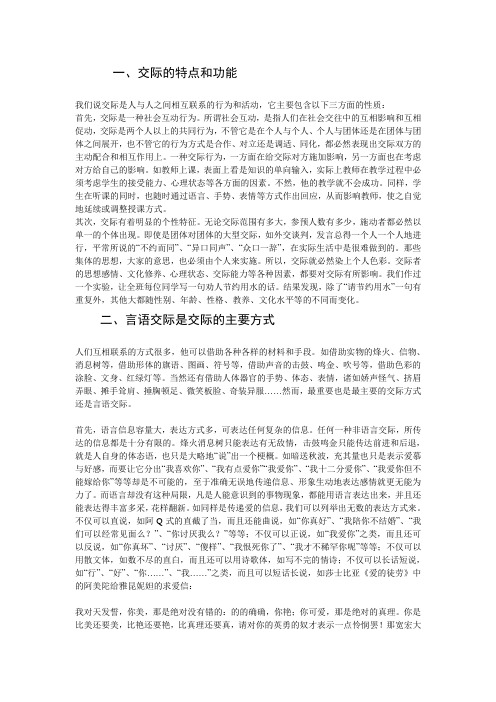
一、交际的特点和功能我们说交际是人与人之间相互联系的行为和活动,它主要包含以下三方面的性质:首先,交际是一种社会互动行为。
所谓社会互动,是指人们在社会交往中的互相影响和互相促动,交际是两个人以上的共同行为,不管它是在个人与个人、个人与团体还是在团体与团体之间展开,也不管它的行为方式是合作、对立还是调适、同化,都必然表现出交际双方的主动配合和相互作用上。
一种交际行为,一方面在给交际对方施加影响,另一方面也在考虑对方给自己的影响。
如教师上课,表面上看是知识的单向输入,实际上教师在教学过程中必须考虑学生的接受能力、心理状态等各方面的因素。
不然,他的教学就不会成功。
同样,学生在听课的同时,也随时通过语言、手势、表情等方式作出回应,从而影响教师,使之自觉地延续或调整授课方式。
其次,交际有着明显的个性特征。
无论交际范围有多大,参预人数有多少,施动者都必然以单一的个体出现。
即使是团体对团体的大型交际,如外交谈判,发言总得一个人一个人地进行,平常所说的“不约而同”、“异口同声”、“众口一辞”,在实际生活中是很难做到的。
那些集体的思想,大家的意思,也必须由个人来实施。
所以,交际就必然染上个人色彩。
交际者的思想感情、文化修养、心理状态、交际能力等各种因素,都要对交际有所影响。
我们作过一个实验,让全班每位同学写一句劝人节约用水的话。
结果发现,除了“请节约用水”一句有重复外,其他大都随性别、年龄、性格、教养、文化水平等的不同而变化。
二、言语交际是交际的主要方式人们互相联系的方式很多,他可以借助各种各样的材料和手段。
如借助实物的烽火、信物、消息树等,借助形体的旗语、图画、符号等,借助声音的击鼓、鸣金、吹号等,借助色彩的涂脸、文身、红绿灯等。
当然还有借助人体器官的手势、体态、表情,诸如娇声怪气、挤眉弄眼、摊手耸肩、捶胸顿足、微笑板脸、奇装异服……然而,最重要也是最主要的交际方式还是言语交际。
首先,语言信息容量大,表达方式多,可表达任何复杂的信息。
- 1、下载文档前请自行甄别文档内容的完整性,平台不提供额外的编辑、内容补充、找答案等附加服务。
- 2、"仅部分预览"的文档,不可在线预览部分如存在完整性等问题,可反馈申请退款(可完整预览的文档不适用该条件!)。
- 3、如文档侵犯您的权益,请联系客服反馈,我们会尽快为您处理(人工客服工作时间:9:00-18:30)。
一、Communication Defined
• Communication is a form of human behavior derived from a need to connect and interact with other human beings. • Communication can simply refer to the act and process of sending and receiving messages among people.
四、The Process of Communication
• 2、Models of communication 、 • (2)Circular Model )
message Encoder decoder message Osgood-Schramm’s Circular Model Decoder encoder
四、The Process of Communication
• 2、Models of communication 、 • (3)Contextualized Model ) • This model adds the dimension of situation or surroundings. Context always affects the act of communication. • Context refers to the idea that every act of communication must happen in some sort of surroundings.
二、Needs and Functions of Communication
• 1、Maslow’s hierarchy of needs 、
• Abraham Maslow is American psychologist, a leader in the school of humanistic psychology. • Maslow is best-known for his theory of human motivation. • His influential works include Motivation and Personality(1954) and Toward a Psychology of Being(1964).
2、Functions of Communication
• • • • (1)Practical function ) (2)Social function ) (3)Decision making function ) (4)Personal growth function )
三、The Classification of Communication
• 1、Components of communication 、 – sender、 、 – encoding、 、 – message、 、 – channel、 channel、 – noise、 、 – receiver、 、 – decoding、 、 – feedback
四 1、Components of communication
Lasswell’s 5-W Linear Model
四、The Process of Communication
• 2、Models of communication 、 • (1)Linear Model ) I say “I like you” to my wife, I (sender) may put into words (encoding) my feelings that “I like you!” (message) and speak the words (channel) in the hope that they will be suitably understood (decoding) by my wife (receiver).
三、The Classification of Communication
Communication Non-social~ ~ Intra-personal~ ~ Interpersonal~ ~ Social~ ~ Organizational~ ~ Mass~ ~
四、The Process of Communication
– the linear, – the circular, – and the contextualized models
四、The Process of Communication
• 2、Models of communication 、 • (1)Linear Model )
Sender Message Channel Receiver Effect
四1、Components of communication
• noise:Noise refers to the disturbances along the : communication processes, which may result in unintended message perceived by the receiver. • feedback:Feedback refers to the reaction from : the message receiver to message sender. • encoding:Encoding refers to the process of the : sender putting the message into a signal (the encoded message) . • decoding:Decoding refers to the process of the : receiver interpreting the signal from the sender.
五、The Characteristics of Communication
• 1、Communication is Dynamic 、 Communication is an ongoing, ever changing activity. • 2、Communication is Irreversible 、 The words are spoken, and they cannot be unspoken. • 3、Communication is Symbolic 、 The symbols you use are discretionary and subjective. • 4、Communication is Systemic 、 Communication does not occur in isolation or in a vacuum, but rather is part of a larger system.
Sender’s Field of Experience
Receiver’s Field of Experience
Sourssage
Decoding
Receiver
Fe
context
Components of Communication
Resp onse
ack edb
• sender:A sender refers to the person who sends : the message. • receiver:A receiver is the one who receives the : message. The role of sender and receiver is always changing. • message:A message——verbal or nonverbal—— : carries ideas from one person to another. • Channel/Medium:Channel refers to the ways for : sending and receiving messages.
三、The Classification of Communication
• (三) In other words, under human communication, we have non-social and social communication; intra-personal is non-social communication while social communication includes interpersonal, organization and mass communication.
四、The Process of Communication
• 2、Models of communication 、 • (1)Linear Model :5Ws )
who Say what In which channel To whom And with what effect A sender Directs a Message Through some Medium To a Receiver With some Effect
Maslow’s hierarchy of needs
二、Needs and Functions of Communication
• 1、Maslow’s hierarchy of needs 、
• While Maslow’s hierarchy of needs is a useful tool, caution should be exercised in employing it in an intercultural setting. • The hierarchy is a theory based on Western behavior and has not been proven applicable to non-Western or developing countries.
